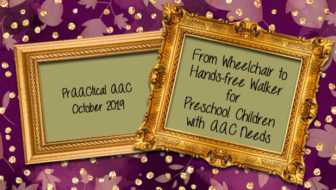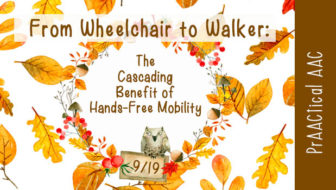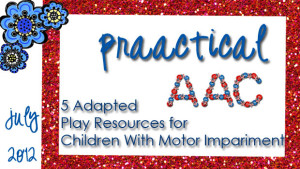October 10, 2019
by Carole Zangari -

We are excited to share the second post in Christine Wright-Ott’s series on promoting hands-free independent mobility in young AAC learners. Christine is an Occupational Therapist and consultant at The Bridge School in Hillsborough California. She authored the chapter “Mobility” in the 4-7th editions of the book, Occupational Therapy for Children. She lectures at universities and conferences including ATIA, Closing the Gap, ISAAC, ISS, and AAC by the Bay. Enjoy! Support Walker Mobility at the Bridge School I would like to share with you an innovative hands-free Support Walker Mobility Program developed at The Bridge School, which is a private school for preschool and elementary children with complex communication and physical disabilities located on the district’s public elementary school campus. It is dedicated to ensuring that students achieve full participation in their communities through the use of augmentative & alternative means of communication (AAC), mobility and assistive technology (AT) applications. ... [Read More...]
Filed under: Featured Posts, PrAACtical Thinking
Tagged With: mobility, mobility impairment, physical disability, young children
September 12, 2019
by Carole Zangari -

When young children with significant motor challenges are unable to move freely around the environment, it impacts many things. Today, we introduce a limited series on why hands-free mobility is so crucial during the early years, and what we can do to promote independent mobility. We are extremely fortunate to have Christine Wright-Ott authoring this series. Christine is an Occupational Therapist and consultant at The Bridge School in Hillsborough California. She authored the chapter, Mobility, in several editions of the book, Occupational Therapy for Children. Christine lectures at universities and conferences including ATIA, Closing the Gap, ISAAC, ISS, and AAC by the Bay. ::::::::::::::::::::::::::::::::::::::::::::::::::::::::::::::::::::::::::::::::::::::: Why Hands-free Mobility Matters for Children with AAC Needs Speech-language pathologists and occupational therapists have long been aware of the many ways that mobility and communication go hand-in-hand. Without a way to move around, a child’s opportunities for incidental learning and motivation to communicate are severely... [Read More...]
Filed under: Featured Posts, PrAACtical Thinking
Tagged With: mobility, mobility impairment, physical disability, young children
July 5, 2012
by Carole Zangari -

Play is the work of children and a gateway to learning about the world. And so when we met a toddler who couldn’t access regular toys for play, we set out on a quest to help solve this problem. Here are some resources we’re using. – Pick out some toys: Sites like AblePlay are invaluable for objective information on which toys to consider. Toys R Us also has a special needs section of their website. How to make battery-operated toys accessible through switches: Instructable by John Schimmel and instructional document by the Alliance for Technology Access How to make battery interrupters so you can make toys switch accessible: Instructable by Gavin Phillips. How to use battery interrupters: Document by AbleNet Once you have your switch-adapted toy, you can make some minor changes to make adapted play a better overall experience Get creative: Creating play environments by Let’s Play. Great info and ideas... [Read More...]
Filed under: PrAACtical Thinking
Tagged With: access, assistive technology, physical disability, play, switch accessible, toys


